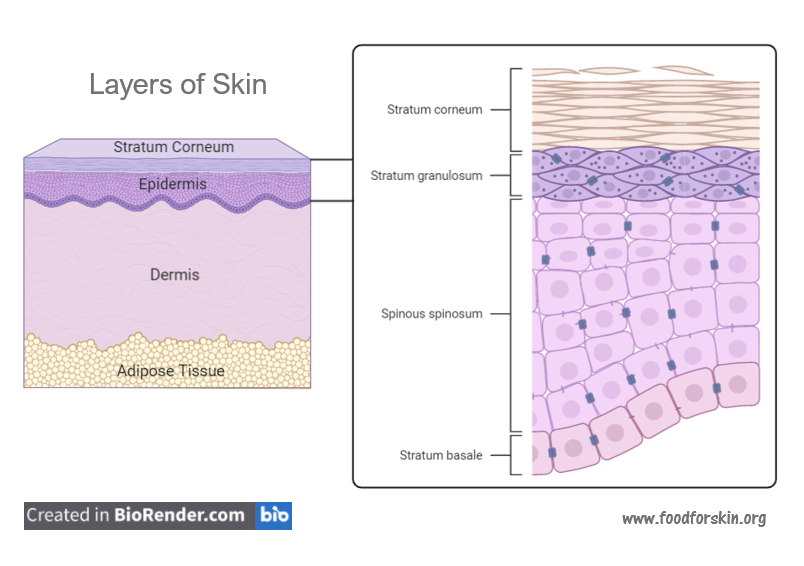101 Series: What’s Your Skin Made of?
Share

If you already know about what’s skin deep, that’s great! If not, no worries, we have got you covered. This snackable read will give you a quick overview of skin structure, composition, and function.
Skin, often termed as the largest organ of the body, guards the underlying muscles, ligaments, bones, and internal organs, and plays a key role in protecting the body against pathogens and excessive water loss. Its other functions are insulation, temperature regulation, sensation, and production of Vitamin D folates. Skin being the organ exposed to the environment is constantly subjected to physical trauma and is also capable of repairing wounds in response to injury. But how can such a flat-looking surface carry out all these tasks? Well, to understand that we should know the basic structure of our skin.
Skin is basically said to have three layers, the epidermis, dermis, and hypodermis/subcutaneous tissue, but depending on scientific semantics, the skin could be classified to have 2-4 layers. For simplicity, let’s say skin is comprised of 2 parts – the superficial, thinner portion is the epidermis, and the deeper thicker part is the dermis. Deep to the dermis is the subcutaneous fat layer called adipose tissue. It is generally not considered as part of the skin, but that notion is debatable.
EPIDERMIS is primarily made of keratinocytes that produce keratin protein (also present in hair and nails), to serve as a protective barrier in combination with various cell components. It usually consists of 4-5 layers, depending on if the top dead layer Stratum Corneum is considered as a part of the epidermis.
Stratum Corneum (horny layer): It is the outermost layer of the epidermis and is composed of dead cells that move up from the layer below it (stratum granulosum). It consists of mostly keratin (protein) and lipid (fat) secretions. This layer is the thickest in the palm and sole region.
Stratum Granulosum: This layer acts as a water repellent layer that helps to reduce the loss of body fluids and entry of foreign materials. It may be only one cell layer thick in a thin skin and up to 10 layers on the palms and soles. The cells release lipid components (fats, waxes, oils, etc.) into the intercellular space, which aids barrier function and intercellular cohesion in the stratum corneum.
Stratum Spinosum (prickle cell layer): It is called the prickle layer as its cells give a spiny appearance due to the presence of desmosomes. Desmosomes are strong connecting junctions in between the cells which provide strength and flexibility to the skin. This layer consists of 8-10 layers of keratinocyte cells (explained later).
Stratum Basale: It is the deepest layer of the epidermis, usually one cell thick and gives rise to keratinocytes. These cells differentiate and move up through the epidermis.
Fun Fact:
The thickness of your skin varies from location to location on your body. E.g., the skin located under the eyes and around the eyelids is the thinnest skin (0.5 mm) in the body and the skin on the palms and the soles of the feet is the thickest (4 mm).
Epidermis majorly consists of four types of cells – Keratinocytes, Melanocytes, Langerhans cells and Merkel cells.
Keratinocytes make up 90% of the epidermis and produce the protein called keratin. This protein protects the skin and underlying tissues from heat, microbes, and chemicals. It releases a water repellent sealant and also controls calcium absorption by activating cholesterol precursors with UVB light-producing Vitamin D.
Melanocytes make up 8% of the epidermis and produce the pigment melanin which contributes to the color of the skin and absorbs damaging ultraviolet light.
Langerhans cells are derived from red bone marrow and migrate to the epidermis. They participate in the immune response against microbes that invade the skin. They make up the first line of defense for the body within the skin.
Merkel cells are touch-sensitive cells usually located in the deepest layer of the epidermis. Merkel cells and tactile discs together detect different aspects of touch sensation.
DERMIS is the thickest layer of the skin separated from the epidermis by the basement membrane. The dermis is composed primarily of ground substance, which includes glycosaminoglycans (GAGs) and the collagen protein. It also contains nerve endings, blood vessels, lymph vessels, oil glands, hair follicles, etc. It plays an important role in regulating body temperature and supplying blood to the epidermis. It is supplied with lots of body water.
Dermis majorly consists of three types of cells – Fibroblasts, Macrophages, and Adipocytes. Fibroblasts provide the structural framework for many tissues and play a critical role in wound healing. They are also liable for synthesizing dermal proteins. Macrophages are also called big eaters as their role is to phagocytose (ingest cell) cellular debris and pathogens. Adipocytes are cells specialized in storing energy as fat.
ADIPOSE TISSUE layer is responsible for the storage of fat and contains blood vessels that supply the skin with nutrients. It is also known as fatty tissue as it consists mainly of fat cells, specialized to synthesize and contain large globules of fat that come from the diet or is produced in the body. It is found mainly under the skin but also in deposits between the muscles, in the intestines and in their membrane folds, around the heart, bone marrow and elsewhere.
References:
1. Harrys cosmeticology, J. D. Wilkinson and R. J. Moore, Longman Singapore Publishers Ltd. 9th Edition. 2015.
2. Wysocki AB. Skin anatomy, physiology, and pathophysiology. Nurs Clin North Am. 1999 Dec;34(4):777-97. [Pubmed]
3. Fuchs E. Epithelial Skin Biology: Three Decades of Developmental Biology, a Hundred Questions Answered and a Thousand New Ones to Address. Curr Top Dev Biol. 2016;116:357 [Pubmed]
If you enjoyed our content, please share, comment, like and follow us on your favorite platforms!
.
.

